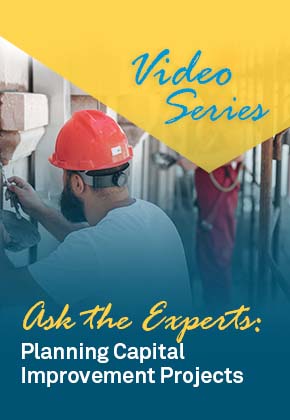 A survey conducted by FirstService Residential found that more than 83% of associations said they are investing in capital improvements, with 20% explicitly focused on adding or enhancing amenities. As a board member, one of your primary responsibilities is to make decisions and policies that enhance property values, so you should proactively invest in capital improvements. Capital improvements are necessary to build your reputation, increase property value, and enrich the resident experience. These can include replacing essential equipment like boilers, air conditioners, and front gates and adding new features like rooftop cabanas on the pool deck.
A survey conducted by FirstService Residential found that more than 83% of associations said they are investing in capital improvements, with 20% explicitly focused on adding or enhancing amenities. As a board member, one of your primary responsibilities is to make decisions and policies that enhance property values, so you should proactively invest in capital improvements. Capital improvements are necessary to build your reputation, increase property value, and enrich the resident experience. These can include replacing essential equipment like boilers, air conditioners, and front gates and adding new features like rooftop cabanas on the pool deck.
“One of the first tasks we take on when partnering with a new property is determining where the board and community stand on capital improvement projects,” said Joe Padron, regional director at FirstService Residential. “Once we help the board solidify the association’s objectives and where they are on reserves, we can then determine a solid and effective plan from there.”
So how do you plan and execute capital improvement projects in your community or high-rise?
1. First, choose the right capital improvements for your association (and residents).
Make sure you are embarking on the right projects and for the right reasons – before making a potentially large investment. Ask, why are we considering a capital improvement project? Is the project a necessary replacement? Is the goal to ensure the structural integrity of a building? Is it an investment that will help you stay current or ahead of the competition?
Take the time to survey owners to understand their wants, needs, and priorities before investing time and money in a capital improvement project. When replacing essential infrastructures, such as elevators and gates, it's important to gather resident feedback if there will be a significant change to the design or function of the equipment. Examples include going to a self-serve guest access gate system instead of a staffed one, or installing new elevators that will require key or biometric access. Residents feel valued when their input is considered, and gathering it now can help mitigate conflicts in the future. Highlighting how the improvement will enhance residents’ lifestyles will make it more palatable, especially if a big price tag is attached to the project.
2. Second, explore project details and requirements with your fellow board members and management company.
If a professional property management company manages your community, ask about similar projects it has managed in other communities. An experienced management company with an extensive portfolio of properties (both local and national) will be able to provide examples at different budget levels. Ask to see the finished projects in person and speak with board members of those communities to learn how the project went. Ask to see projects at varying levels of complexity. For example, one project may involve new carpeting, another may involve carpeting and hallway renovations, and the next may involve carpeting, hallway renovations and lobby updates. Compare costs to judge what a little extra investment can do for your community.
Explore the details and requirements of your project, including pricing, design options, and a rough timeline – and the project manager who will get the job done on time and within your budget. Once your board has determined the best options, it must communicate that information to residents for their consideration.
Most people do best when they have something to look at before making a choice. Host an owners’ informational meeting where the designer, architect and/or engineer can present their ideas and provide an open forum for residents to ask questions. The goal is for owners to feel involved, understand the scope of the project and get an idea of what to expect as the project proceeds. Make sure to summarize the discussion and share it with owners who were not able to attend.
Keeping the community informed throughout the project, especially if there are delays or complications, is important after you have solicited feedback, presented options and received buy-in.
“One of the communities we manage was considering levying a special assessment to fund a capital improvement project – upgrading the floor of a common area to marble,” said Padron. “We worked closely with the board to communicate the project plan to residents and ask them for feedback for the board to consider before making their final decision.” Including residents in the process is always a good idea – regardless of the final outcome.
3. Third, determine your funding options.
Make sure you have the funds to complete the project before making any plans. Review your reserves and other funding options first. When replacing essential equipment, your reserve fund should always be the starting point. If your reserve study and assessments have aligned, you should have the funds on hand to replace things like HVAC equipment and pool pumps without borrowing money, raising dues or needing any other assessments. Your property management company and financial provider can help you identify possible funding sources if your reserves aren't sufficient.
Communities need to consider what needs to be done with a limited reserve budget – and what would be nice to do. But according to Ashley Rader, director at FirstService Residential, they’re not always mutually exclusive. “Sometimes it makes sense to consider enhancing a job that must be done with one that is nice to have. For example, suppose the community has decided to redo the pool deck because it’s become worn and slippery and could pose a safety hazard to residents (definitely a “needs to be done”). In that case, the board might consider enhancing that project with a “nice to have,” say, resurfacing the pool, which might not be needed for another year, but that will make good use of the investment the board is making to redo the deck. It may cost less to add that on than to start from scratch a year from now.”
Once you’ve identified the right funding options, it’s time to get to work.
4. Fourth, bring on your project manager.
Bring in your project manager once you know what you want to accomplish and how you will pay for it. A project manager is critical to the success of your project. They are usually a licensed engineer, with expertise in construction projects and the knowledge to inspect contractor work and develop a timeline to keep the project moving on schedule. Don't expect your property manager to manage your projects. Your property manager is not licensed or qualified to handle this type of work.
“One problem we’ve seen with capital improvement projects is when a board expects the property manager to also be the project manager. Our property managers can administer the project – to make sure everything runs smoothly – but they need to prioritize managing your community,” explained Padron. “Boards must contract a project manager who is an expert on the specific type of project and can focus on managing the project timeline and budget and conducting inspections.”
Remember, your property manager is responsible for running your community, leading your staff, overseeing your budget, paying your bills and making sure that preventive maintenance is done properly.
Begin soliciting bids and vetting vendors once your project manager is on board. A good property management company will have a list of reliable and vetted vendors to help you get started. Your project manager will also have the skills and knowledge to assist with vetting. FirstService Residential's extensive portfolio and presence in Georgia – and all of North America ¬– enable associations to see examples of capital improvement projects in comparable communities or high-rises and receive valuable tips and best practices for selecting vendors.
5. Fifth, finalize the project details, including project manager, board, management company and vendor responsibilities.
It is understandable that many board members are hesitant to take on capital improvement projects on their own. With the right management company and project manager on your side, you can rely on them to help facilitate the capital improvement project, from concept to communication and everything in between. Danny Ellis, president at FirstService Residential, said, “Property managers will work with the board to determine a scope of work, collect bids, present bids to the board and help negotiate contracts. We do whatever makes the job go more smoothly, including making sure that bills are paid on time. We also work closely with your project manager, ensuring that they have the information, tools and support they need to get the job done properly.”
6. Finally, expect the unexpected.
It is important to remember that even if you plan every detail, choose the right vendors, communicate thoroughly, and fund your capital improvement, the unexpected can still occur. Installing a new elevator, for instance, may require another change, such as upgrading the fire panel. The weight of an elevator may change after the floor tiles are updated, requiring new testing and certification. A city inspector may recommend or require other work to be done to bring an area up to code after tearing down a wall. Often, cosmetic changes end up being more than cosmetic, and a professional engineer is the best person to guide your association through this process.
No matter what type of community you lead, capital improvements are part of managing an association. Although they may be costly, neglecting or delaying needed improvements might cost you more in the long run. A professional property management company should have the experience, resources, and knowledge to help your association plan and execute capital improvement projects successfully.

Watch the full video!
When you live in a community association, capital improvement projects are a fact of life, yet many board members struggle with the complexities they present. Watch our video to learn how to kick off your next capital project.
WATCH NOW!